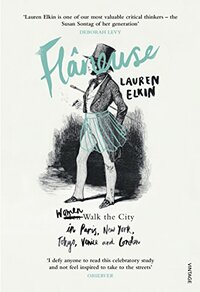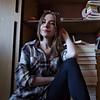You need to sign in or sign up before continuing.
Take a photo of a barcode or cover
228 reviews for:
Flâneuse: Women Walk the City in Paris, New York, Tokyo, Venice and London
Lauren Elkin
228 reviews for:
Flâneuse: Women Walk the City in Paris, New York, Tokyo, Venice and London
Lauren Elkin
The disperate parts (memoir, bios about famous women artists) didn't coalesce into a book about walking for me. If it was marketed as a book about moving to Paris this rating would be completely different
A mishmash that works surprisingly well together: the history of women who walk in cities (*flaneuses,* to match the male term *flaneurs*); biography of some female writers like Jean Rhys, George Sand, and Martha Gellhorn; academic discussions on the social meaning of the suburb; the history of Paris; the plot of an art film; fragments of memoir from the author, which serve to keep it from being too academic. It’s a hard line to walk, that mixing of memoir—inherently intimate—and erudition—which lends a detached air whether it means to or not; I’m honestly not sure I’ve ever found an example I’ve found wholly successful. Still, while I can’t bring myself to consider *Flaneuse* a must-read for anyone, if the topic interests you, you will almost certainly get something out of it.
What we build not only reflects but determines who we are and who we’ll be. ‘A city is an attempt at a kind of collective immortality,’ wrote Marshall Berman in an essay on urban ruin: ‘we die, but we hope our city’s forms and structures will live on’. The opposite is true in the suburbs. They have no history and don’t think about the future; very little there is built to last. Posterity is irrelevant to a civilisation living in an ongoing, never-ending present, with as much care for the future or sense of the past as a child. In his classic 1961 study *The City in History*, Lewis Mumford describes the naivety of the suburbs, which sustain in their inhabitants a ‘childish view of the world’, a false impression of security, if not an outright political apathy. Terrible things happen elsewhere, but never here, not now, not to us. It’s the most natural parental instinct to want to give your children a better childhood than your own; but the generation of city dwellers who invented the suburbs blew past ‘better’ in their pursuit of an impossible social isolation. It is as if they were trying to give not only their children but *themselves* the childhood they never had. The suburbs present the world to their children as if padded in felt, as if life were something gradually accumulated through commercial transaction, store by store. Often American literature and films about the suburbs feature children and adults losing their innocence, surprised, unprepared, for how terrible life can be: *The Virgin Suicides*, *American Beauty*, *Revolutionary Road*, *Weeds*—all of these ask not only ‘is that all there is?’ but ‘is there really that, too?’
reflective
medium-paced
reflective
slow-paced
The book meanders, unsurprisingly. I didn’t realize it would be a memoiristic set of essays inspired by the lives and essays of others. It was okay I guess
adventurous
challenging
emotional
funny
hopeful
informative
inspiring
lighthearted
reflective
medium-paced
adventurous
challenging
funny
hopeful
informative
inspiring
lighthearted
mysterious
reflective
relaxing
medium-paced
Being somewhat of a Flâneuse myself, I was looking forward to jumping into this one. It turns out that I had a mixed experience. On one hand, some of the historic information was surprisingly enjoyable. On the other, some of it was long-winded and seemingly irrelevant. Some sections really conveyed the author's experience, while others seemed to be holding back considerably. Overall, I would say that it starts off strong and generally goes downhill. However, there were enough nuggets of information and inspiration, throughout, to make me glad I read the whole thing.
I found it an interesting topic, but a bit disorganized. There were too many chronological jumps, back and forth, which were confusing.
I picked this book up in a bookstore in York (England) when I was just wandering around taking photos and stopping for coffee to write, so of course this seemed like a good book to pick up.
The book weaves together a chosen city with a famous and artistic woman who either lived in the city or spent time there and walked the streets of the city and how it connects to the author and her time in the same city and how it helped their creativity or hindered it and how they worked around it.
I liked that I learned some things about creative and artistic women I either only knew a little bit about (Martha Gellhorn) or people I knew very little about (Calle). The author goes deep into that part, or parts, of their lives on how they moved through their environment or changed environments to meet their needs, to support their art, and live life. I found this quite intriguing. She weaves together a compelling story about the women she features in the book and I left each chapter feeling like I knew these women quite well. The author is a good story teller.
I also like that the book was heavy on Paris since it is the city that I have been to the most (outside of NYC) and that the chapters on Paris are split between different areas of topic and different women flaneuse. The women that each of the three discussions on Paris focus on are women worth reading about and studying: Jean Rhys, George Sand, and Agnes Varda. I knew some about all three, but as mentioned above, I left each chapter with a sense of knowing them better and wanting to know more. It felt intimate in the details. If Paris is not your thing or is somewhere you despise, then this book may rub you the wrong way since the author clearly loves Paris and chooses to live there.
I'm a fan of books where the author inserts themselves into other artists lives either through history lessons or through personal interactions with the artist and/or their art and through a filter that matters to them (flaneusing in this case). I like reading a perspective that may or may not be my own or may or may not be art that interests me or that I know about. It is a curiosity factor and this book fit that bill. The memoir portion of the book was not intrusive and I found it to be some of the places where I didn't want to put the book down, for example, the chapter on Tokyo.
This is not a travel book or a book about pragmatic ways to maneuver through the cities in the book as a woman. It is a book about how some women artists used walking a city as part of their art or as a way to get creative juices flowing or unblock creativity and about their lives in those cities while intertwining as a memoir of sorts.
I enjoyed this books and the writing.
The book weaves together a chosen city with a famous and artistic woman who either lived in the city or spent time there and walked the streets of the city and how it connects to the author and her time in the same city and how it helped their creativity or hindered it and how they worked around it.
I liked that I learned some things about creative and artistic women I either only knew a little bit about (Martha Gellhorn) or people I knew very little about (Calle). The author goes deep into that part, or parts, of their lives on how they moved through their environment or changed environments to meet their needs, to support their art, and live life. I found this quite intriguing. She weaves together a compelling story about the women she features in the book and I left each chapter feeling like I knew these women quite well. The author is a good story teller.
I also like that the book was heavy on Paris since it is the city that I have been to the most (outside of NYC) and that the chapters on Paris are split between different areas of topic and different women flaneuse. The women that each of the three discussions on Paris focus on are women worth reading about and studying: Jean Rhys, George Sand, and Agnes Varda. I knew some about all three, but as mentioned above, I left each chapter with a sense of knowing them better and wanting to know more. It felt intimate in the details. If Paris is not your thing or is somewhere you despise, then this book may rub you the wrong way since the author clearly loves Paris and chooses to live there.
I'm a fan of books where the author inserts themselves into other artists lives either through history lessons or through personal interactions with the artist and/or their art and through a filter that matters to them (flaneusing in this case). I like reading a perspective that may or may not be my own or may or may not be art that interests me or that I know about. It is a curiosity factor and this book fit that bill. The memoir portion of the book was not intrusive and I found it to be some of the places where I didn't want to put the book down, for example, the chapter on Tokyo.
This is not a travel book or a book about pragmatic ways to maneuver through the cities in the book as a woman. It is a book about how some women artists used walking a city as part of their art or as a way to get creative juices flowing or unblock creativity and about their lives in those cities while intertwining as a memoir of sorts.
I enjoyed this books and the writing.
Eh. I loved the premise and some of the chapters. But I was less interested in the author's situation --
I wanted much more about other women writer-walkers throughout history.
I wanted much more about other women writer-walkers throughout history.





